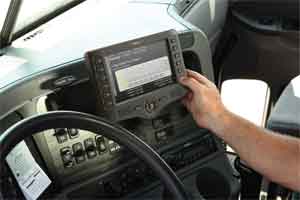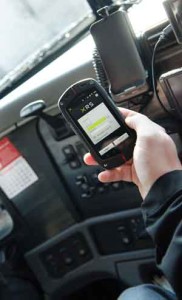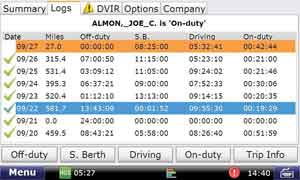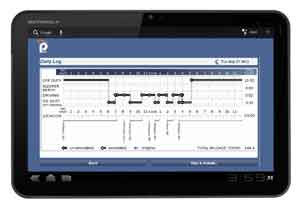Electronic onboard recorders (EOBRs)—or electronic logging devices (ELDs), as they are now being called—installed in commercial vehicles can monitor and record a whole host of data about a vehicle and its driver. And because ELDs are the subject of a pending mandate that will require them for tracking hours of service (HOS), fleets are beginning to pay very close attention.
Since they track much more than HOS—electronic vehicle inspection reports; driver behavior reporting on speeding, idling and hard braking; and integrated map and route solutions, to name a few—many fleets have adopted ELDs ahead of the mandate in order to reap a multitude of benefits.

Legislation update
When the ELD mandate was first passed as part of the Highway Reauthorization Bill (MAP-21) a year ago, it required the Federal Motor Carrier Safety Administration (FMCSA) to issue a final rule for the mandate by October 2013, according to Dave Kraft, spokesperson for Qualcomm subsidiary Omnitracs. Additionally, the mandate required that any new parameters be in effect within two years of the final rule being issued, so by October 2015.
“The timeline has since shifted based on federal process requirements for rulemaking,” Kraft notes.
According to John Gaither, HOS/EOBR specialist for GPS Insight, “FMCSA was burned pretty badly by its most recent attempt to mandate EOBRs when it was successfully sued by the Owner Operator Independent Drivers Association (OOIDA).”
In that case, a court rescinded the HOS rule, agreeing with OOIDA that issues of potential harassment were not sufficiently addressed by FMCSA. Because of this, “the new rule is being very carefully worded and FMCSA is behind schedule in releasing it,” Gaither adds.
“We can probably expect to see the next set of proposed rules this September,” says Christian Schenk, senior vice president of product and market strategy for XRS Corp. “Following the proposed rules, it’s expected there will be a public comment period of 60 days—this could be longer, but 60 days is typical. After the comment period, the new rules could be issued in fall of 2013, or slip into 2014—the time between the end of the comment period and issuance of final regulation can vary due to the review process and number of significant comments.
“The effective date for enforcement of the mandate is two years after issuance of the final rule, most likely later in 2016—this is to allow the suppliers to update software to meet the compliance of the new regulation,” Schenk adds.
Omnitracs’ Kraft explains that part of the reason for the lengthy schedule is the extensive scope of the EOBR mandate rulemaking. Key areas to be addressed in the upcoming proposed rule include:
• ELD mandate and requirements for these systems as directed in MAP-21.
• Technical performance requirements that were addressed in a prior 395.16 EOBR rulemaking—with several updates recommended by the Motor Carrier Safety Advisory Committee.
• New guidelines to mitigate the potential for driver harassment as required in response to prior litigation.
• Additional requirements for compliance records management by the carrier’s support system, based on a previous proposed rulemaking that was delayed.
“While it’s hard to determine a final implementation date, I can note that once the final rule is ready the industry will need 12-18 months to develop and bring certified products to market,” Kraft says. “Then, once the products are available, it is expected the industry will need an additional 24-36 months to implement EOBRs into more than two million trucks that have not already installed one. We also expect a transition provision that allows carriers that have implemented current EOBR systems in advance of the final rule to continue the use of those systems for their remaining useful life.”

Benefits to fleets
ELDs offer much more than the ability to track HOS, providing significant benefits to both drivers and fleets, according to Alexis Capelle, EOBR program manager for Continental Corp., who adds, “For starters, they help reduce the driver’s administrative workload by eliminating the need to complete paper logs. Because EOBRs reduce the possibility of errors in the drivers’ logs, they can help to eliminate HOS violations and lead to better CSA scores.”
In fact, ELDs practically eliminate the two most common driver violations—form and manner, and record of duty status not current—which make up 25% of the total violations issued to a driver, according to Elise Chianelli, PeopleNet’s product manager, safety and compliance.
“Managing a driver’s hours, knowing where your equipment is, using GPS to automate your fuel tax, and the ability to communicate to the driver using the device messaging system gain tremendous advantages for the carrier, which relate to operational savings and a safer driver,” Chianelli adds. “Let’s not forget about the 2012 cell phone ban for drivers and that trying to communicate with them puts that driver in harm’s way. There is no ban on a fixed mount device.”
Joshua DeCock, director of product management for Pedigree Technologies, says ELDs help fleets increase regulatory compliance, increase fleet safety and decrease operational costs. “There are a lot of side benefits to EOBRs if you choose the right solution,” he explains. “Tracking performance of your fleet can lead to significant fuel savings, fuel tax reporting, reduced speeding violations and awareness of vehicle diagnostics. Scheduling, dispatching and electronic forms can piggy back on the same device and take a business to the whole next level.”
Rand McNally’s Mason Meadows, director of mobile communications, estimates drivers gain back 20 minutes per day, the average time that would have been spent completing paper logs. In addition, logs are always up-to-date since driving is automatically detected and logs are then updated.
“Fleet managers have near real-time visibility to the drivers’ available hours or projected reset time,” Meadows says. “This allows load planners to assign the optimal driver to a load and accurately project ETAs that match the driver’s available hours. A driver’s log follows him from vehicle to vehicle, so if a driver gets out of one truck and into another, he just logs into the system on the new truck and his previous seven days, plus today, download immediately and he continues on the new trip.”
XRS Corp.’s Schenk points out the devices make weigh station and roadside inspections more streamlined, with law enforcement personnel able to quickly check standardized digital records. “In general, drivers won’t have to spend their valuable time doing paperwork or worrying about potentially costly accounting errors,” he says, adding, “EOBRs take the guesswork out of record-keeping for the driver.”
GPS Insight’s Gaither adds that drivers often can gain as many as two hours of available duty time in a typical 60- or 70-hour week because the device rounds off-duty status changes to the nearest minute, rather than forcing the driver into a 15-minute grid as with paper logs.
Omnitracs’ Kraft lists some further EOBR applications beyond electronic driver logs and HOS monitoring:
• Fuel management and fuel use monitoring to improve controls and reduce costs
• In-cab navigation to reduce unnecessary miles and costs
• Driver performance monitoring to detect patterns of aggressive driving or inefficient vehicle operation, where coaching often improves results
• Vehicle diagnostics monitoring to identify preventive maintenance needs
• In-cab training to ensure timely availability and delivery of driver safety training
Tackling misconceptions

As ELDs become more widely accepted, fleets—and drivers—are learning their benefits far outweigh any perceived drawbacks. Fears of lost productivity and driver turnover, in addition to a perceived high cost and little to no return on investment, were initial barriers to adoption of the technology ahead of a mandate, Gaither notes.
“Some fleets have been reluctant to adopt EOBRs due to the initial implementation processes and hardware costs—viewing EOBRs as an additional and unnecessary expenditure,” Kraft adds. “Also, smaller fleets might not understand the broader benefits EOBRs offer their organization, since they have less people and vehicles to manage and/or track. However, if used consistently, fleets can drastically reduce operating costs and achieve long-term revenue, productivity and safety improvements as outlined above.”
XRS’ Schenk says some fleet managers have expressed concerns about making EOBR devices tamper-proof, a problem that has plagued European EOBR mandates amid the proliferation of easily-corrupted devices.
“There are a lot of myths regarding EOBRs and most of them come back to the belief that it will cost fleets more time each day and more money to implement,” DeCock says. “Regarding EOBR costs, it is much less than most realize and the ROI is so rapid that most businesses wish they had put a system in place long ago.”
Continental’s Capelle notes most misconceptions are due to confusion about what EOBRs really are, as well as a fear of the unknown. “The simple act of switching from paper to electronic logs will mean that some carriers will need to change their business procedures, and this change can be disruptive to the operation. As a result, a majority of carriers have elected to wait and see how others are making out with EOBRs before deciding to make the switch themselves.
“Then we have nagging uncertainty about the actual requirements that will be in the final rule,” he adds. “While the FMCSA has not yet issued its ruling, some are afraid that current systems will not be able to match future requirements. The good news is that the FMCSA has included a grandfather clause in both the past proposed and final EOBR rules and will likely keep it in the future final rule.”

Driver concerns diminished
Aside from fleet management concerns, drivers also had worries regarding ELDs/EOBRs, particularly the perceived lack of privacy.
“Many drivers were concerned that EOBRs would be used as a tool to monitor ALL of their activities and thereby infringe on their privacy,” Capelle says. “As drivers began to use and experience the value of EOBRs, they found out that this was not the case and began to realize the true benefits of EOBRs.
“By providing accurate information on their remaining driving time, eliminating errors and violations and reducing the paperwork, EOBRs make life a lot easier,” he adds. “Drivers also like the fact that EOBRs are accurate to the minute, so short stops do not have to be rounded out to 15 minutes as with paper logs.”
“We hear the ‘big brother’ comment a lot,” Rand McNally’s Meadows says, “and some truck drivers and owner-operators choose the profession because they like being in charge of their day. When they think about the company knowing where they are all the time, it just rubs them the wrong way.
“The fact is—and this has been proven over and over—once the technology is in their truck, drivers experience tremendous benefit. It helps them do their jobs more efficiently, reduces stress and generally makes their lives easier. In many cases, our fleet customers report that drivers can’t imagine going back to paper logs after becoming comfortable with the technology.”
Pedigree Technologies’ DeCock concurs: “The classic problem drivers have with EOBRs is they don’t want big brother looking over their shoulder. No one wants that, but it is much less invasive than most drivers think. After that initial resistance, what we’re actually seeing is drivers realizing that it takes less effort on their part and can actually be their defense if they are asked to drive more hours than is legal.”
It’s human nature to think of change as a burden, but according to PeopleNet’s Chianelli, training and driver understanding make for successful implementation of electronic logs. “Once drivers start using eLogs, they do not want to go back. All the recapping, all the making the lines match, the time it takes to look back at their fuel receipts, toll tickets, bill of ladings, etc., makes drivers realize it takes some pressure off of them because their managers see the same things they do.”
Lastly, Omnitracs’ Kraft notes that many drivers have found that EOBRs help them focus more exclusively on driving, rather than administrative tasks, and help ensure they aren’t pushed to drive long and unsafe hours.

Selecting the right device
Each of the ELD/EOBR makers polled for this article offered valuable insight for fleets when it comes to choosing the best device for their operations.
XRS Corp.’s Schenk says it’s important to look at the length of the contract period with an EOBR provider, as contract lengths vary from vendor to vendor. “Some, like XRS, offer no-commitment contracts, while others extend to five years. Make sure you take a close look at the fine print before you sign on the dotted line.”
He also suggests other questions to consider: Does your EOBR vendor offer other services? How will your vendor support your successful EOBR implementation?
“Additional vendor services vary, but may include implementation, training and overall customer support,” Schenk adds. Based on your fleet size and the extent to which you plan on using the system, these added services may be critical to your successful solution rollout.”
“Make sure you look at hardware cost, monthly service, installation cost, warranty terms, network operator and service coverage,” advises Rand McNally’s Meadows. “Also look beyond the HOS to see what other applications are offered that may benefit your company. The system you purchase is a tool and the more you use it, the more you get in return. For instance, you want a system that is flexible enough to be able to change your rate plan as you move to more data in the future and you want to make sure they have an integration capability with your TMS software provider.”
PeopleNet’s Chianelli cautions, “It is important to note that when the government says ‘mandate,’ it means carriers have to buy something. When that happens, vendors crawl out of the woodwork claiming to offer compliant devices and prices will be all over the place. The driver and the carrier are responsible for being compliant, not the vendor. Company history and profitability have to be part of the decision equation—as carriers make that investment, they have to be assured that company is going to be here later to continue to support and innovate their product.”
Omnitracs’ Kraft recommends smaller fleets, or fleets with a consistent driving schedule, initially focus on compliance and select a less costly EOBR that offers minimal application access, such as HOS and Vehicle Inspection Report coverage. For larger fleets with more unpredictable routing needs, he advises purchasing an EOBR that incorporates a wider selection of features, functionality and applications.
“When making a decision, it’s best to call the technology vendor directly to discuss the unique needs of your fleet and gain insight on the best EOBR system for your organization,” Kraft adds.
DeCock, of Pedigree Technologies, cautions, “Carefully listen to the company selling the EOBR and see if they talk about the effort involved in implementing this technology. If they say it is really easy, turn and run the other way. Look for a technology company to partner with you to implement EOBRs and not one that will just throw the technology over the wall.”
Similarly, GPS Insight’s Gaither advises, “Make sure the vendor is committed to future compliance and identify any costs of future updates. Ask the vendor to loan sufficient equipment for a real-time trial and experience the hardware and software in action. Share experiences with similar fleets using the vendor’s equipment and services.”
Lastly, Continental’s Capelle offers the following advice regarding system reliability, presentation and total cost of ownership versus benefits:
• System reliability—Fleets need to make sure the system will work where and when they need it. They will have to balance out this need against the desire to maximize as many fleet management features and services they can on one device, such as a smartphone or tablet. If they commit the HOS function to this type of device, they need to consider the potential consequences if the electronic log fails to work because of an operating system update, lack of cellular reception or failure of a smartphone, creating an out of compliance situation for the driver. While other apps running on a tablet or a smartphone may not be as critical if they are not available for a period of time, the electronic log must always be available.
• Presentation—It is important to consider the manner in which the logs be shown to enforcement at roadside checks. Will it be via a display or a printout? Enforcement officers cannot be expected to learn how to use all of the different systems that are in the field, so the information produced by the EOBR must be self-explanatory, instant and very easily accessible. If a roadside check is conducted where there is no cellular connectivity, will the system still be able to instantly produce the logs and prove compliance? In the case of a mobile or integrated display, what happens if the mobile display in the cab is inoperable or not available because a driver removed it?
• Total cost of ownership versus benefits—Does the system have startup costs and monthly fees? Is additional hardware, such as a smartphone and a separate monthly fee for a data plan required? What is the expected lifetime of the system’s components? Smartphones will typically have a much shorter lifetime (two years) than an automotive box (five to 10 years). In addition to calculating the total cost of ownership over five years per vehicle and per driver, fleets will need to consider the minimum contract duration required by the supplier.
